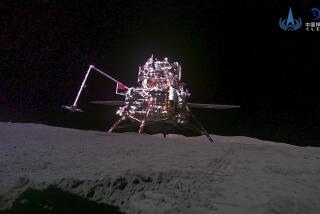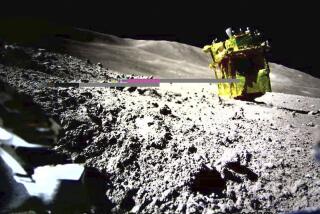Japan’s First Moon Probe Launched Into Orbit
UCHINOURA, Japan — This nation’s first lunar probe was put into orbit around the Earth on Wednesday, ending a 14-year gap between moon missions and giving new prestige to Japan’s space program.
Space center officials said the Muses-A satellite, as planned, separated from its Nissan-made rocket several minutes after liftoff Wednesday night from an oceanside launch site in southern Japan.
Mission chief Hiroki Matsuo said data from tracking stations in California and Australia showed the satellite was orbiting the Earth at a maximum distance of 186,000 miles.
The satellite in its highly elliptic orbit is to close within 11,250 miles of the moon by March 18.
At that time, shortly before it crosses the moon’s path in a “swing-by,” it is to release a second, smaller satellite, which will be propelled into lunar orbit about 10,000 miles from the moon.
The smaller satellite will send data to its mother satellite detailing the lunar region’s temperatures and electrical fields.
The launch originally was scheduled for Tuesday, but the countdown was stopped with 18 seconds remaining because of an electrical problem in the hydraulic system.
Only the United States and the Soviet Union have sent missions to the moon, the most recent being the 1976 landing of an unmanned Soviet vehicle.
The mission is a symbolic step for Japan’s growing space program, which has relied more on diligent engineering than large budgets.
“This time we are going to the moon. But our objective is not the moon itself,” Matsuo said. “Our institute is getting into interplanetary missions in the 1990s, and for that we need to refine our technology.”
Both the Institute of Space and Astronautical Science, which is conducting the moon mission, and Japan’s other space agency, the National Space Development Agency, have plans for manned space flights and interplanetary travel.
NASDA, which focuses on applied uses of space, also is developing a small space shuttle and a new all-Japanese rocket, the H-2, that will handle a payload comparable to those carried by U.S., Soviet and European rockets.
The Nissan rocket used in the launch carried a payload of only 400 pounds. The H-1 rocket is expected to handle a two-ton load.
Japan’s first satellite was launched in 1970. Muses-A is the 13th Japanese satellite in operation.
In recent years, Japan has achieved a respected aerospace launch record, despite its late entry into the field, low budgets--$1.06 billion last year--and a shortage of good launch sites.
More to Read
Sign up for Essential California
The most important California stories and recommendations in your inbox every morning.
You may occasionally receive promotional content from the Los Angeles Times.










